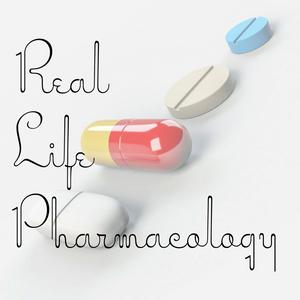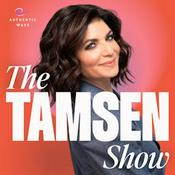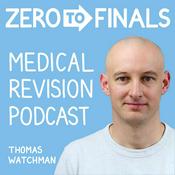Real Life Pharmacology - Pharmacology Education for Health Care Professionals

412 episodes

Pimavanserin Pharmacology Podcast
2026/1/01 | 12 mins.
Pimavanserin is an atypical antipsychotic approved for the treatment of hallucinations and delusions associated with Parkinson’s disease psychosis. Unlike traditional antipsychotics, it does not block dopamine receptors, making it a unique option for patients with Parkinson’s disease who are highly sensitive to dopamine antagonism. Mechanism of Action Pimavanserin works primarily as a selective serotonin 5-HT2A inverse agonist and antagonist, with minor activity at 5-HT2C receptors. This dopamine-sparing effect is the key reason it does not worsen motor symptoms in Parkinson’s disease. Adverse Effects The most commonly reported side effects include peripheral edema, nausea, confusion, and hallucinations. QT interval prolongation is a clinically important concern, especially in patients with existing cardiac risk factors. Somnolence may occur but is generally less prominent compared with dopamine-blocking antipsychotics. Warnings and Precautions Pimavanserin carries a boxed warning for increased mortality in elderly patients with dementia-related psychosis, consistent with other antipsychotics. It should not be used in patients with known QT prolongation, a history of ventricular arrhythmias, or in combination with other QT-prolonging agents when possible. Drug Interactions Strong CYP3A4 inhibitors, such as ketoconazole or clarithromycin, can significantly increase pimavanserin concentrations and require dose reduction. Strong CYP3A4 inducers, such as rifampin or carbamazepine, may reduce efficacy and should generally be avoided. Additive QT prolongation may occur when combined with other QT-prolonging medications, including certain antiarrhythmics, fluoroquinolones, and macrolide antibiotics. Be sure to check out our free Top 200 study guide – a 31 page PDF that is yours for FREE! Support The Podcast and Check Out These Amazing Resources! NAPLEX Study Materials BCPS Study Materials BCACP Study Materials BCGP Study Materials BCMTMS Study Materials Meded101 Guide to Nursing Pharmacology (Amazon Highly Rated) Guide to Drug Food Interactions (Amazon Best Seller) Pharmacy Technician Study Guide by Meded101

Antihypertensives Test Prep and Practice Pearls; Part 3 – Aldosterone Antagonists and Vasodilators
2025/12/25 | 14 mins.
Aldosterone antagonists, such as spironolactone and eplerenone, are potassium-sparing diuretics that block aldosterone at the mineralocorticoid receptor in the distal nephron. By reducing sodium and water reabsorption while conserving potassium, they play a key role in heart failure, resistant hypertension, and primary hyperaldosteronism. Clinically, they improve mortality in heart failure with reduced ejection fraction, making them much more than just “add-on” diuretics. From a safety standpoint, the biggest concerns with aldosterone antagonists are hyperkalemia and renal function decline. These risks increase in patients with chronic kidney disease or when combined with ACE inhibitors, ARBs, or potassium supplements. Spironolactone can also cause endocrine-related adverse effects such as gynecomastia and menstrual irregularities, which is why eplerenone may be preferred in some patients. Direct-acting vasodilators, most notably hydralazine and minoxidil, lower blood pressure by relaxing arteriolar smooth muscle and reducing systemic vascular resistance. Hydralazine is commonly used in heart failure in combination with nitrates, particularly in select patient populations, while minoxidil is reserved for severe, refractory hypertension due to its potency. Despite their effectiveness, direct-acting vasodilators come with important clinical trade-offs. Reflex tachycardia and fluid retention are common, so they are typically prescribed alongside a beta blocker and a diuretic. Hydralazine is associated with drug-induced lupus, while minoxidil can cause significant edema and hypertrichosis, making careful patient selection and monitoring essential. Be sure to check out our free Top 200 study guide – a 31 page PDF that is yours for FREE! Support The Podcast and Check Out These Amazing Resources! NAPLEX Study Materials BCPS Study Materials BCACP Study Materials BCGP Study Materials BCMTMS Study Materials Meded101 Guide to Nursing Pharmacology (Amazon Highly Rated) Guide to Drug Food Interactions (Amazon Best Seller) Pharmacy Technician Study Guide by Meded101

Antihypertensives Test Prep and Practice Pearls; Part 2 – ARBs and Thiazides
2025/12/18 | 16 mins.
This podcast is designed to help pharmacy and nursing learners cut through the noise and focus on the high-yield concepts that matter most when it comes to angiotensin receptor blockers (ARBs) and thiazide diuretics. These two medication classes show up constantly on exams and in clinical practice, yet small details about their mechanisms, adverse effects, and monitoring parameters are often where test questions try to trip you up. Each episode is built to reinforce those key points in a clear, practical way. We’ll break down how ARBs and thiazide diuretics work, why they are commonly used in hypertension and other disease states, and how to quickly differentiate them from similar drug classes. Special attention is given to classic exam “gotchas,” such as electrolyte changes, renal considerations, and patient populations where these medications are especially beneficial or should be used with caution. Beyond test prep, this podcast emphasizes real-world practice pearls that translate directly to patient care. You’ll hear concise explanations of what to monitor, what side effects matter most clinically, and how to recognize problems early. These insights are especially helpful for nurses, pharmacy students, and new clinicians who want to feel confident applying pharmacology knowledge at the bedside or in clinic. Whether you’re studying for boards, preparing for a pharmacology exam, or just looking to sharpen your clinical skills, this podcast delivers focused, high-yield content in an easy-to-follow format. By the end of each episode, you’ll walk away with practical takeaways that improve both your test performance and your day-to-day medication management. Be sure to check out our free Top 200 study guide – a 31 page PDF that is yours for FREE! Support The Podcast and Check Out These Amazing Resources! NAPLEX Study Materials BCPS Study Materials BCACP Study Materials BCGP Study Materials BCMTMS Study Materials Meded101 Guide to Nursing Pharmacology (Amazon Highly Rated) Guide to Drug Food Interactions (Amazon Best Seller) Pharmacy Technician Study Guide by Meded101

Antihypertensives Test Prep and Practice Pearls; Part 1 – ACEIs and CCBs
2025/12/11 | 13 mins.
Welcome to today’s episode, where we dive into two cornerstone classes of antihypertensives: ACE inhibitors and calcium channel blockers. These drugs are among the most frequently prescribed agents in both primary care and specialty settings, making a solid understanding of their practical nuances essential for clinicians, pharmacists, and learners alike. In this episode, we’ll break down the most important clinical pearls that can immediately improve your prescribing confidence and patient care. We’ll start with ACE inhibitors, a class often selected for patients with hypertension, heart failure, diabetes, and chronic kidney disease. While widely effective, ACE inhibitors come with monitoring requirements and predictable side effect profiles that clinicians must recognize early. We’ll highlight what changes in renal function are acceptable, how to navigate issues like hyperkalemia and cough, and when switching to an ARB may be the safest option. Next, we’ll move into calcium channel blockers, emphasizing the differences between dihydropyridines and non-dihydropyridines—two groups with distinct effects and unique considerations. I outline amlodipine’s adverse effects and how to navigate a patient who is experiencing edema. By the end of this episode, you’ll walk away with a set of high-yield, easy-to-apply pearls that you can use in your next patient encounter. If you use antihypertensives and treat hypertension, heart failure, arrhythmias, or chronic kidney disease, this episode will help sharpen your understanding of these foundational therapies and elevate your medication management strategies. Let’s get started. Be sure to check out our free Top 200 study guide – a 31 page PDF that is yours for FREE! Support The Podcast and Check Out These Amazing Resources! NAPLEX Study Materials BCPS Study Materials BCACP Study Materials BCGP Study Materials BCMTMS Study Materials Meded101 Guide to Nursing Pharmacology (Amazon Highly Rated) Guide to Drug Food Interactions (Amazon Best Seller) Pharmacy Technician Study Guide by Meded101

Moxifloxacin Pharmacology
2025/12/04 | 14 mins.
Moxifloxacin is a fourth-generation fluoroquinolone that works by inhibiting bacterial DNA gyrase and topoisomerase IV—two enzymes essential for DNA replication, repair, and transcription. By blocking both targets, it provides broad-spectrum activity against gram-positive, gram-negative, and atypical pathogens. Its enhanced gram-positive coverage, especially against Streptococcus pneumoniae, distinguishes it from earlier fluoroquinolones like ciprofloxacin. Pharmacokinetically, moxifloxacin has excellent oral bioavailability, meaning the PO and IV doses are essentially interchangeable. It distributes well into tissues like the lungs and sinuses, making it a frequent choice for respiratory infections. With a long half-life of about 12 hours, once-daily dosing is standard. Adverse effects are similar to the fluoroquinolone class, with concerns including tendonitis and tendon rupture, QT interval prolongation, CNS effects like confusion or agitation—particularly in older adults—and the risk of peripheral neuropathy. Moxifloxacin is especially notable for a higher propensity toward QT prolongation compared with some of its peers, making it important to avoid in patients with existing QT issues or those taking other QT-prolonging medications. Be sure to check out our free Top 200 study guide – a 31 page PDF that is yours for FREE! Support The Podcast and Check Out These Amazing Resources! NAPLEX Study Materials BCPS Study Materials BCACP Study Materials BCGP Study Materials BCMTMS Study Materials Meded101 Guide to Nursing Pharmacology (Amazon Highly Rated) Guide to Drug Food Interactions (Amazon Best Seller) Pharmacy Technician Study Guide by Meded101
More Education podcasts
Trending Education podcasts
About Real Life Pharmacology - Pharmacology Education for Health Care Professionals
Listen to Real Life Pharmacology - Pharmacology Education for Health Care Professionals, Pepp Talk Podcast and many other podcasts from around the world with the radio.net app

Get the free radio.net app
- Stations and podcasts to bookmark
- Stream via Wi-Fi or Bluetooth
- Supports Carplay & Android Auto
- Many other app features
Get the free radio.net app
- Stations and podcasts to bookmark
- Stream via Wi-Fi or Bluetooth
- Supports Carplay & Android Auto
- Many other app features


Real Life Pharmacology - Pharmacology Education for Health Care Professionals
download the app,
start listening.






































